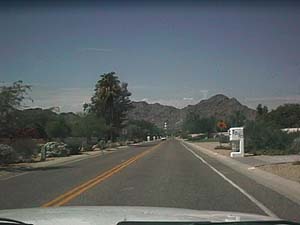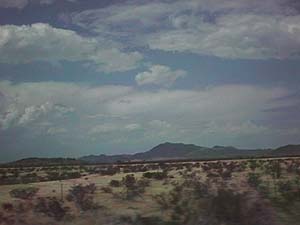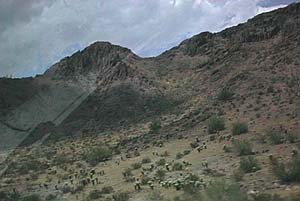hen Rhonda was done with a long series of phone calls, I was finally able to get on the internet. She had me "pull up" some web pages of rental property that interested her in her ongoing search for a Scottsdale condo for her sister Bettie. Both Kim and I did our best to sell Rhonda on the idea of getting herself internet service, telling her that it was an almost-free and increasingly-comprehensive form of global communications. I pointed out that it was a far better in many ways than using the phone: it's much cheaper and there's a permanent record of what has been said. While I was showing Rhonda these few things on the internet, AOL kept crashing on me and she said (not jokingly, mind you) that these problems (which she didn't remotely understand) were indications that I'm not all the computer genius Kim had claimed.
im and I packed the car, said our goodbyes and (yet again) hit the road, this time taking I-10 through Phoenix and out across the desert towards California. Phoenix is a non-descript city; take away the palm trees and weird mountains and it looks just like Cleveland, Ohio. I was most upset when I couldn't find the cigarette lighter power adapter for the laptop. This meant that I could do no writing during the long drive to San Diego. Little things like this eat at me and put me in a pout. Kim is sensitive to my emotions, so involuntarily sympathetically, she was soon in a bad mood as well. We squabbled several times, but the scenery was so spectacular it was easy to be distracted from our ridiculous funk. The desert was bleak, especially the rough mountains, some of which looked to be entirely made of rock and dust with no plant life whatsoever. But the plain, no matter how bleak it became, was never without some sort of plant cover. For most of Arizona, there were the sea-plant-like ocotillos and various kinds bushes at regular intervals (depending on the local moisture) across the flatland, while on the mountains and other kinds of relief, Saguaro and small cacti were the dominant vegetation. Storm clouds gathered in a few places and for a few brief moments we were pelted with huge drops of rain.
We gradually dropped down into the Colorado River valley by a series of steps, each with a low cliff demarcating the edge of that level of erosion.
hen we crossed the Colorado River in California, there was an agricultural inspection station looking like some kind of international customs. These Californians really do think they're an independent nation. Neither Kim nor I had ever been through such a thing before (though my mother had mentioned them), having no idea how badly we'd be roughed up. We hid the marijuana and paraphernalia just in case, but all the guy did was ask where we were coming from, and when Kim said Phoenix, he just waved us through. The California side of the Colorado River valley was intensively agricultural, with irrigation trenches and forms of irrigation hardware I'd never seen before. The plant diversity was much reduced once we returned to the desert. There were no more Saguaro Cactus, and the few bushes were very tiny little banzai things set about five feet apart, each on its own hump of sand. In a few dry river beds, the willow-like Palo Verde (which has green photosynthesizing twigs and nearly-vestigial leaves) could still be found, but they were much less common than they had been in Arizona. In some places, a kind of grass (at this time of year sand-yellow in colour) covered the spaces between the bushes. We could see little tornados of dust here and there in the distance.
uddenly Kim noticed her car was overheating and she wanted to know what to do. We had been running the air conditioner and driving 80 mph, and I suggested she go much slower, turn off the air conditioner and roll down the windows. So from there until we reached an exit on the summit of a peculiar bulge in the desert plain, we crawled along at 50 mph with hot desert air blowing on us. Sophie the Miniature Schnauzer seemed to be the most uncomfortable with the situation (she was also suffering from hives as a result of yesterday's harsh flea treatment), so I dappled some water on her. We stopped for gas, lunch and to let the car cool down at a fun & folksy gas station/restaurant/antique store at the highest point in the valley south of Joshua Tree National Park. A mother black cat and her two adolescent black kittens relaxed on the moist soil under the watered palms outside in the shady patio area where we ate our restaurant food with Sophie. A strong desert wind blew, making conditions almost pleasant. I had a barbecue beef burger, my decidedly inappropriate first meal in California. The kittens were willing to eat barbecued beef but not french fries. Sophie, of course, was happy to eat anything and possibly would have taken a bite out of one of the kittens had they come much closer.
drove the rest of the way to San Diego. We came down out of the eastern desert to the Whitewater River Valley, walled on the east side by high bleak mountains resembling those on Mars. These stood beyond eroded mounds of gravel that superficially resembled sand dunes. On the valley floor itself, though, was another region of intensive irrigated agriculture. But there were also a great many palms, groups of which even appeared to be growing wild. The map indicates that this valley floor here is below sea level. As we drove up out of the vicinity of Palm Springs, we passed through a mountain pass thickly populated with modern windmills designed to generate electricity. I've seen these things in movies and such, but I had no idea that there were so many of them. They covered the land like just another crop, taking advantage of the strong winds blowing from the cool ocean out into the hot desert.
The mountains started looking substantially less arid. On their lower slopes they were still dry, but higher up was dense dark green foliage of some kind.
he miles passed, though I couldn't tell directly how many there were; in its arrogance, California doesn't use mile posts or numbered exits. From Beaumont we took route 60, winding on thrilling curves among small, steep, grass-covered hills. I understood why small sports cars are so popular in this state. We avoided the complications of driving near Los Angeles by heading south on I-215, passing through a region characterized by bushy mountains covered with huge round boulders. Kim wanted to drive along the Pacific coast for a distance, but as we were heading for Oceanside, we heard traffic reports of congestion, so we got back on I-15 and tried instead to cut over to the coast at La Jolla. But this time we managed to get lost in the complexities of San Diego's streets. Eventually we gave up on the coast and took the freeways the rest of the way, to our new home in Normal Heights, San Diego, California. Our new neighborhood had a certain gritty charm, especially the business district along Adams Avenue. But the residential blocks surrounding our new home were a familiar kind of suburban, the only major difference was the presence of palm trees and simulated adobe.
need to go through a bit of the history of how Kim found herself a place to live in San Diego. The massage school she'll be attending put her in touch with a housing service that connects students (usually foreign students) with homeowners (usually ex-patriots from other countries) who are willing to house students in extra rooms or out-buildings. Using this service, Kim was connected with Rita, a 60-something French Canadian woman with a pregnant miniature Schnauzer named Suzette. Kim and Rita hit it off very well via telephone and email; people with Schnauzers almost seem to constitute a secret society, complete with handshakes, rituals and code-language. Even when Kim dropped the big one, that she had fallen in love and was bringing her boyfriend (me), Rita was accepting. Rita is an energetic, practical, funny woman with a delightful French Canadian accent. She admits to starting too many projects and being unable to carry them through. She gave us a tour of her house, the cabana where we'll be living, and her walled-in back yard (complete with an orange tree and a hot tub). The yard was in the process of being made-over in a desert theme, with dirt, bricks and plants waiting in piles to be incorporated in whatever her design will be. Rita was still painting the cabana and was worried about us breathing the fumes, so we set up beds in the living room where we'd be sleeping tonight. We walked Suzette and Sophie the dogs around the block. Each time the dogs would poop, Rita would make up some kind of excuse for why we shouldn't have to pick it up. "It's too small!" and "It's too dark now and I can't see it!" Her benign sociopathy was delightful. Rita fixed us a sort of Greek salad which we ate with boxed white wine. Ah, boxed vino. I haven't drunk boxed vino since the days of Kappa Mutha Fucka, when Morgan Anarchy told me about the "space bags" in those boxes. We all went to bed early. The night air was cool, as Fall is in the East.
|
 home |
musings index |
feedback |
other journals
home |
musings index |
feedback |
other journals



